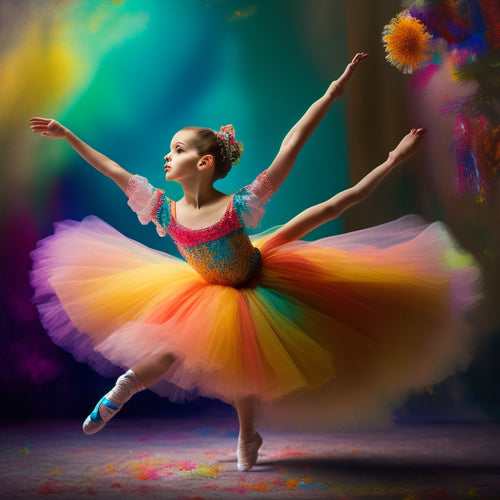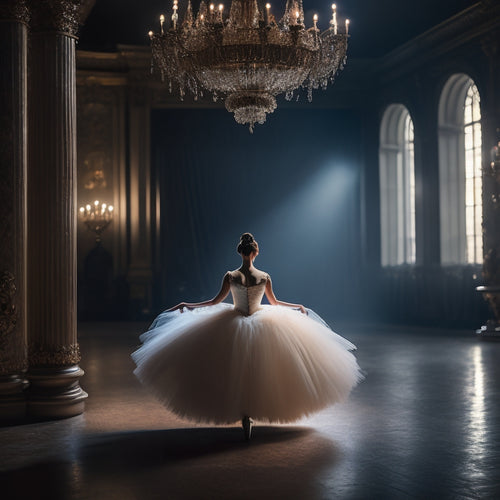
Unveiling The Dancers' Path: A Performance Guide
Share
A dancer's journey to excellence is a harmonious integration of physical technique, artistic expression, and mental focus, requiring a deep understanding of the intricate balance between these elements to tap into their full performance potential. By mastering technical fundamentals, building a strong foundation, and refining performance quality, dancers can surpass technical proficiency and embody the music, fostering a profound connection with the audience. As dancers navigate the path to excellence, they can reveal the secrets to igniting their full artistic expression, and in the following pages, discover the nuances of this transformative journey.
Key Takeaways
• Integrate physical technique, artistic expression, and mental focus to master the art of dance and unlock your full expressive potential.
• Establish a solid foundation through discipline, consistency, and routines to ensure proper technique, prevent injuries, and optimize performance.
• Develop a growth mindset to overcome self-doubt, fear of failure, and technical limitations, and transcend to embody the music.
• Refine your performance quality by exploring musicality nuances, cultivating a deeper connection with the audience, and revealing confidence.
• Dedicate yourself to deliberate practice, persistence, and exploration of new styles and techniques to unleash your full performance potential.
Mastering the Art of Dance
To master the art of dance, a performer must harmoniously integrate physical technique, artistic expression, and mental focus, cultivating a holistic understanding of the craft that extends beyond mere technical proficiency.
Exploring various techniques and enhancing skills through deliberate practice are essential components of this process. By doing so, dancers can refine their movements, develop musicality, and convey emotional depth.
Moreover, they must cultivate a growth mindset, embracing challenges as opportunities for growth and self-improvement. As dancers navigate the complexities of their craft, they must remain adaptable, resilient, and open to constructive feedback.
Through dedication and persistence, they can transcend mere technicality, tapping into the full expressive potential of dance.
Building a Strong Foundation
Establishing a solid foundation is essential for dancers, as it enables them to develop proper technique, prevent injuries, and optimize their performance. A strong foundation is built on discipline and consistency, which can be achieved by establishing routines that prioritize proper warm-ups, stretching, and practice.
Developing discipline is vital in maintaining a consistent routine, allowing dancers to refine their skills and adapt to new techniques. By establishing routines that focus on proper technique, dancers can prevent injuries and optimize their performance.
A strong foundation also enables dancers to explore new styles and techniques, leading to artistic growth and expression. By focusing on building a strong foundation, dancers can realize their full potential and achieve freedom of expression through movement.
Unleashing Your Performance Potential
As dancers master the fundamentals of technique and develop a strong foundation, they can then focus on refining their performance quality, exploring the nuances of musicality, and cultivating a deeper connection with their audience.
Revealing confidence is key to accessing true performance potential. This involves overcoming obstacles such as self-doubt, fear of failure, and criticism. By developing a growth mindset and embracing challenges as opportunities for growth, dancers can break free from limitations and tap into their full artistic expression.
Through dedication, persistence, and a willingness to take risks, dancers can transcend technical proficiency and embody the music, revealing a profound connection with their audience. By doing so, they can access their true performance potential and experience the freedom of unbridled expression.
Frequently Asked Questions
What Is the Ideal Age to Start Professional Dance Training?
While there's no one-size-fits-all answer, research suggests that an early start (around 5-8 years old) can foster technical proficiency, but late bloomers can still achieve success with dedicated practice, highlighting the importance of individualized approaches to dance training.
How Do I Balance Dance Practice With Other Aspects of My Life?
Can one truly master the art of dance without mastering the art of balance in life? Effective time management and prioritized self-care are essential in harmonizing dance practice with other aspects of life, allowing dancers to thrive freely.
Can I Still Become a Professional Dancer With a Prior Injury?
While a prior injury may present challenges, it's not an insurmountable barrier to a professional dance career. By adapting to injury setbacks, dancers can modify techniques to accommodate physical limitations, and with dedication, still achieve success in the industry.
What Are the Most Essential Dance Styles to Learn for Versatility?
Did you know that 75% of professional dancers incorporate multiple styles into their repertoire? To achieve versatility, focus on mastering Cultural Fusion and Genre Bending techniques, blending styles like ballet, contemporary, hip-hop, and jazz to unleash limitless creative expression.
How Do I Handle Criticism and Rejection in the Dance Industry?
To handle criticism and rejection in the dance industry, cultivate mental toughness by developing self-acceptance, recognizing that setbacks are opportunities for growth, and fostering a growth mindset to overcome obstacles and thrive in a competitive environment.
Related Posts
-

Group Dance Makeup Tutorials for Online Success
As you immerse yourself in the world of group dance makeup tutorials, you'll need to master essential makeup techniqu...
-

Artistic Fusion: Lerma's Little Dancer Triumphs
As I reflect on my artistic journey, I'm struck by the profound evolution that has occurred, marked by the triumphant...
-

Unveiling Ballet: Insider Insights on Dance World
Ballet, an art form esteemed for its elegance and beauty, conceals a world of rigorous dedication, meticulous plannin...


